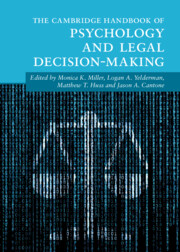Book contents
- The Cambridge Handbook of Psychology and Legal Decision-Making
- Cambridge Handbooks in Psychology
- The Cambridge Handbook of Psychology and Legal Decision-Making
- Copyright page
- Dedication
- Contents
- Figures
- Tables
- Editors
- Contributors
- Part I Introduction Chapters
- 1 A Modern Approach to the Psychology of Legal Decision-Making
- 2 “I Hope the Final Judgment’s Fair”
- 3 Diversity and Bias in Legal Decision-Making
- 4 Judicial Decision-Making
- Part II Pretrial Phase Decision-Making
- Part III Trial Phase Decision-Making
- Part IV Postconviction Phase Decisions
- Part V Other Legal Decision-Making
- Part VI Perspectives from the Field
- Part VII Conclusion
- Index
- References
3 - Diversity and Bias in Legal Decision-Making
Broadening Frameworks and Addressing Overlooked Issues
from Part I - Introduction Chapters
Published online by Cambridge University Press: 22 February 2024
- The Cambridge Handbook of Psychology and Legal Decision-Making
- Cambridge Handbooks in Psychology
- The Cambridge Handbook of Psychology and Legal Decision-Making
- Copyright page
- Dedication
- Contents
- Figures
- Tables
- Editors
- Contributors
- Part I Introduction Chapters
- 1 A Modern Approach to the Psychology of Legal Decision-Making
- 2 “I Hope the Final Judgment’s Fair”
- 3 Diversity and Bias in Legal Decision-Making
- 4 Judicial Decision-Making
- Part II Pretrial Phase Decision-Making
- Part III Trial Phase Decision-Making
- Part IV Postconviction Phase Decisions
- Part V Other Legal Decision-Making
- Part VI Perspectives from the Field
- Part VII Conclusion
- Index
- References
Summary
Biases in decision-making based on race, ethnicity, social class, gender, sexual orientation, and other social identities are pervasive in the criminal justice and legal systems. Likewise, the positionality of legal actors and lay people from diverse groups both influences and constrains legally relevant judgments. This chapter uses a case study of racially biased judgments in the criminal justice and legal systems to illustrate how judgment processes can lead to unequal outcomes across social groups. It then describes ways in which law-psychology can expand research on diversity in legal decision-making, addressing issues related to social class, discrimination against LGBTQ+ people, and reproductive decision-making by women. It also discusses frameworks and perspectives that provide valuable insights on legal decision-making but which often are overlooked by psycholegal scholars, including intersectionality, Critical Race Theory, and the abolition movement. The chapter concludes by examining the limits of a decision-making framework for understanding unequal outcomes in legally relevant contexts, which frequently are the result of structural and implicit biases in addition to deliberate judgments.
Keywords
- Type
- Chapter
- Information
- Publisher: Cambridge University PressPrint publication year: 2024

